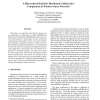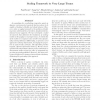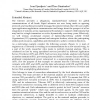34 search results - page 3 / 7 » Collaborative Capability of Teams in Network Organizations |
IPPS
2003
IEEE
14 years 3 months ago
2003
IEEE
Clustering is an important characteristic of most sensor applications. In this paper we define COSMOS, the Cluster-based, heterOgeneouS MOdel for Sensor networks. The model assum...
ATAL
2004
Springer
14 years 3 months ago
2004
Springer
As a paradigm for coordinating cooperative agents in dynamic environments, teamwork has been shown to be capable of leading to flexible and robust behavior. However, when we appl...
ITRUST
2004
Springer
14 years 3 months ago
2004
Springer
Abstract The Internet provides a ubiquitous, standards-based substrate for global communications of all kinds. Rapid advances are now being made in agreeing protocols and machine-p...
CSCW
2006
ACM
14 years 3 months ago
2006
ACM
Task dependencies drive the need to coordinate work activities. We describe a technique for using automatically generated archival data to compute coordination requirements, i.e.,...
ICPW
2007
13 years 11 months ago
2007
The Rule Responder project (responder.ruleml.org) extends the Semantic Web towards a Pragmatic Web infrastructure for collaborative human-computer networks. These allow semi-autom...



